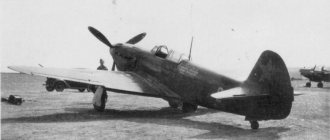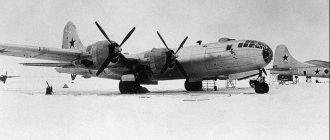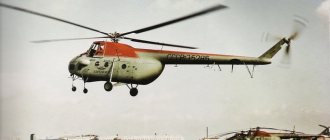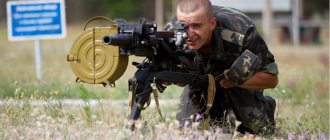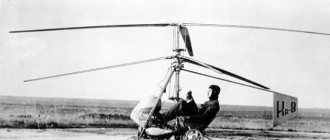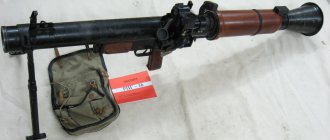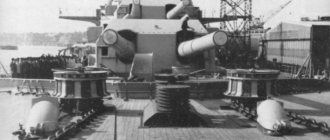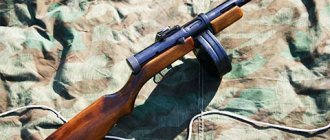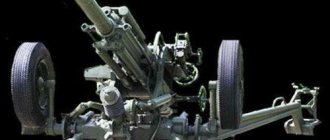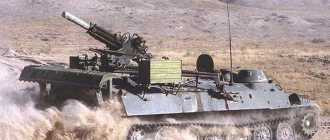The 30s of the last century became a period of rapid development of aviation in the USSR. Air parades, films about hero pilots, the opening of flying schools throughout the country, setting new records for altitude, speed and flight range - aviation has become a real cult for the young Country of the Soviets. The heavy bomber TB-3 (or as it was also called ANT-6) is a true symbol of that era. Not a single air parade was complete without this giant, the TB-3 has many records, this plane landed on drifting ice floes and took part in the war in Spain.
In 1939, the TB-3 was withdrawn from service with Soviet bomber units, but after the outbreak of war it returned to service. The ANT-6 was used throughout the war as a bomber and transport aircraft. The history of the use of TB-3 in the first months of the war is one of the most dramatic pages of Soviet aviation.
In honor of the merits of the air veteran, TB-3 was included in the air column of the Victory Parade, but due to bad weather the aviation flight was canceled.
At the time of its creation, the TB-3 was considered the pinnacle of design thought; many technical solutions used in the creation of this aircraft determined the development of heavy aviation for decades to come. This was the merit of the brilliant designer A.N. Tupolev and the team of AGOS TsAGI, where the TB-3 was developed.
A total of 816 bombers were built. Over the years of serial production, about ten modifications of the aircraft were developed. TB-3 was produced from 1932 to 1937.
The history of the creation of the legendary TB-3
The history of the TB-3 began in 1925 after the leadership of the Soviet Air Force turned to TsAGI with the requirement to create a heavy multi-engine bomber with a wheeled or ski chassis and a total engine power of at least 2000 hp. With.
Design of the new car began the following year, with Tupolev leading the design team. The military changed and clarified the characteristics of the new aircraft several times; the final technical specifications appeared only in 1929.
The TB-1 aircraft was taken as the basis. Initially, they planned to install Curtiss V-1570 engines (590 hp) on it, and then replace them with Soviet Mikulin-17 engines. After all the calculations had been completed and the tests had been carried out, the layout of the new bomber was finally approved in 1930. It was built in the shortest possible time, and already in December 1930 the first aircraft took off. The flight was successful. It was decided to put the car into mass production.
The aircraft prototype has been modernized. BMW-VIz 500 engines (720 hp) were installed on it, and the area of the horizontal tail was increased. The single-wheeled chassis of the English company Palmer were considered weak and were replaced with domestically produced wheeled bogies.
After production began, it turned out that production aircraft were 10-15% heavier than the prototype.
This problem was solved not only by designers, but also by plant workers, each of whom was offered one hundred rubles per kilogram lost. In the end, the weight of the bomber was reduced by 800 kg. Subsequently, serial TB-3s had variations in weight, sometimes reaching several hundred kilograms.
It must be said that such problems often plagued Soviet aircraft manufacturers. The reason for this was the low technological standard of production and the unsatisfactory quality of components and materials. All this led to the fact that production aircraft differed significantly (for the worse, of course) from the prototypes. This phenomenon became especially widespread during the war.
Subsequently, Tupolev continued to work on reducing the weight of the TB-3 and improving its aerodynamic shape. He subsequently came to the conclusion that better streamlining of large and low-speed aircraft does not lead to a significant improvement in basic performance. Although, he still managed to reduce the weight of the TB-3.
Russian aircraft need reliable engines
IL-76: workhorse of the Airborne Forces. Photo: United Aircraft Corporation The hero of the Syrian air bridge and the anti-terrorist operation in Kazakhstan, the heavy military transport Il-76 made its first flight on May 5, 1973 from the airfield of the Tashkent aviation plant. The plane was piloted by a crew under the command of test pilot Alexander Tyuryumin. Subsequently, the Il-76 of various modifications was produced at the Tashkent Aviation Production Association named after V.P. Chkalov (TAPOiCh), a total of 955 aircraft were built over the years of production, more than a hundred of which were sent for export. Production volumes reached 72 aircraft per year! This is true, by the way, as a guideline for the United Aircraft Corporation. Production was transferred to Ulyanovsk from Uzbekistan, but they can’t even dream of such production rates there.
VTA is the key to victory
In the 90s of the last century, almost 300 Il-76 aircraft remained in Ukraine. I saw with my own eyes a forest of airplane tails at the airfield in Zaporozhye ten years ago - as many as five divisions of military transport aviation (MTA) were based in Nezalezhnaya. All the equipment remained there. They sold some, but many Ilyushas were permanently parked. Maintaining airworthiness and resource is a very burdensome matter. Without regular maintenance, these are no longer airplanes, but scrap metal. In the United States, there are huge sites for such aircraft cemeteries in the Nevada desert. At least the equipment there does not rust, and it is possible to restore it to working condition. In Ukraine, as in Russia, the climate is much more aggressive. So today the Ukrainian armed forces have only five Il-76 aircraft. In general, there are about 400 “live” aircraft scattered across different countries.
Support the publication
- Join the CLAN
Or
Sometime in ten years, after the launch into series, 250 Il-76s were delivered to the troops. Now the 14th Il-76-MD90A, including the prototype, is being delivered in Ulyanovsk. And also in ten years . But we must remember that of the 130 BTA aircraft, most are on their last legs, flying with the remaining lifespan. They are still Soviet-built. In January, everything was thrown into action, of course, including new aircraft, more than 70 aircraft. Here we must pay tribute to the Russian Armed Forces - they managed to concentrate forces and resources. But what next? The plant in Ulyanovsk promises to produce 12 aircraft per year, but this is not so much.
There is a way to modernize existing combat vehicles - to the Il-76MDM version. With repairs and increased service life. The engines, however, will remain the same, D-30KP 2nd series. But this needs to be done, the work needs to be financed. Why not take the path of installing new engines on these aircraft to add range and payload capacity? Most likely, Perm engine builders are simply not ready to provide more powerful and economical PS-90s to newly built aircraft and those undergoing modernization. Plus, the plant and design bureau are busy with the production of PD-14 engines for the passenger MS-21, and the creation of the heavy-duty PD-35. At the same time, until recently, modernization was carried out by the pilot production of PJSC Il, but now it has been practically liquidated, leaving only 123 ARZ (aircraft repair plant) in Staraya Russa. The company is capable of repairing and modernizing up to 15 Il-76 aircraft per year, as stated on the 123ARZ website.
There is only one conclusion - the industry needs to set the task of modernizing BTA aircraft, producing new ones, monitoring execution and ensuring financing of the work. It is high time to prepare a worthy replacement for the super-heavy giant An-124 - these aircraft do not last forever, and the Il-76 is tailored to the equipment of the Airborne Forces. Large air defense systems, such as the S-400, can only be airlifted by the Ruslan. Our country is very large, even if we put aside operations abroad, it will be more and more difficult to quickly redeploy troops from East to West or vice versa. But the creation of a super-heavy transport aircraft directly depends on engine builders .
When there is a plane, but no engine
The investigation into the Il-112V crash near Kubinka has turned into a very strange series. It seems that it no longer matters what caused the death of the crew and the plane, the main thing is that by the end of January the culprit company must be identified. Engine specialists, naturally, do not want to be extreme; objectivity fades into the background.
“Klimov” continues to resist – they say that the Ilyushinites are to blame. But this is not the first time they have gone through a similar story. In July 1993, during a test flight, there was an engine failure on takeoff - of the nine crew members and experimenters, two survived. The propeller of the second engine, immediately after separation, due to a failure in the electronic control unit, spontaneously switched to the feathering mode, which is why the stall mode was reached. The aircraft engines also became the main reason for the forced “landing” of the aircraft.
Another thing is fundamentally important - the passenger Il-114-300 is on the ground, the tests have been stopped - it has the same TV7-117ST engine as on the deceased Il-112V. The sluggish construction of two light military transport Il-112V in Voronezh also signals that without reliable engines the aircraft has nothing to do in the sky. And who will be ready to fly a plane whose most important unit, the engine, can present any nasty thing - from a failure of the control system to a fire? Suicide bombers among test pilots disappeared a century ago, a little less - at the dawn of aviation. Then we went into the unknown, today most of the risks can be calculated. Who will take the responsibility to tell the pilots and crew, test engineers: “Fly, everything will be fine!” The pilots are not crazy, after the known failures and fire of the TV7-117ST-01 engine, a disaster, they can send them to hell. And they will be right. No one has the right to force people to fly questionable equipment into the sky. On passenger and military transport aircraft there are no cases of the crew abandoning the aircraft in emergency situations - they wait until the last minute. Even during test flights, engineers often sit behind the pilots with their equipment and without parachutes. And no one has ejection seats!
Personnel shortage?
The personnel problem in the aircraft industry has long come to the fore. Where there is money, where they pay a decent salary, specialists run there. At Ilyushin they pay 40 thousand rubles, and at Irkut, where they created the medium-haul airliner MS-21, for the same position - 140. Any questions? No questions! The aircraft project was launched at the beginning of the 2000s. In 2002, a preliminary design was already ready. But, as usual, problems arose with financing, and the first MC-21s are promised to be put into operation with American engines in 2022. The pace is discouraging. For comparison: the Soviet aircraft industry produced a new aircraft every five years, not all together, but individual design bureaus.
Will the Urals taxi?
How the motorists will get out of this situation is unknown. Enormous amounts of money have been spent from the budget, decades of work have passed, and the output is a low-resource engine that does not produce the required power, with a bunch of childhood illnesses and failures. He was boosted twice, and, most likely, it was because of this that he presented a surprise in the form of a fire in flight. And the engine for the Il-112V and Il-114-300 is needed not even today, but yesterday.
By the way, they do this without taking into account weight reduction; the documentation from the design bureau has just finished being transferred to the plant. The Ministry of Defense is silent. But the Ministry of Industry and Trade is stuck with the ODK-Klimov engine and doesn’t want to hear about anything else. Despite the fact that there are options, “Arguments of the Week” wrote about the powerful and technologically advanced, almost ready-made turboprop engine from Samara TVD-4, a modernized version of the NK-4, certified and flown on the wing of the Il-18 airliner. Maybe none of the decision-makers want to take responsibility or, even worse, are sabotaging the renewal of the military transport aviation fleet of the Russian Aerospace Forces? True, one very interesting information came from the UWCA press service:
“The Supervisory Board of the Industrial Development Fund approved a loan of 2 billion rubles to the Ural Civil Aviation Plant.” With the help of a preferential loan, the enterprise will carry out technical re-equipment, this will speed up the launch of serial production of gas turbine aircraft engines and increase the capacity for their overhaul. The total budget of the project will be 5.7 billion rubles, while the level of localization of production should reach 85%,” said the Minister of Industry and Trade of the Russian Federation, Chairman of the Supervisory Board of the FRP Denis Manturov. The loan was approved within the framework of the Federal Investment Fund’s “Priority Projects” program, which is aimed at financing large manufacturing enterprises.
The company will purchase more than 30 units of modern high-precision equipment. During the implementation of the project, 155 jobs will be created.
The main customers of the engines will be aviation, Polar Airlines, Aerosila, Orenburg, Volga-Dnepr and Kamchatka Aviation Enterprise.
“We plan to move from repairing aircraft to developing and manufacturing new engines. Cooperation with the IDF will help UWGA JSC “in the development of high-quality production, which will be the basis for the production of aircraft as part of our large-scale development plans,” said Vadim Badekha, General Director of UWGA JSC. The company will receive funds after signing a loan agreement with the Federal Investment Fund.”
“AN” has already written that UZGA today is the best candidate for the production of aircraft engines for regional aircraft. Yekaterinburg has technology, it has modern workshops and equipment, and personnel. And most importantly, interest; the plant plans to produce the entire line of aircraft for local and regional airlines, except for the Il-114. But the plans include a turboprop regional passenger aircraft TVRS-44 with a capacity of up to 50 seats. This is to replace the An-24, An-26, Yak-40. So a reliable domestic engine is very necessary for them too.
Add AN to your sources so as not to miss important events - Yandex News
Become a member of the CLAN and every Tuesday you will receive the latest issue of “Arguments of the Week” with a discount of more than 70%, along with exclusive materials not included in the newspaper. Get premium access to a library of the most interesting and popular books, as well as an archive of more than 700 published issues for FREE. In addition, you will have the opportunity to benefit from free legal advice from our experts for a whole year.
- Enter your email address, then select any convenient payment method for your annual subscription
- Scan the QR. In the Sberbank Online application that opens, enter the annual subscription cost (490 rubles). Then send the confirmation code by email
Or
Stay with us. Add us to your sources and subscribe to our social networks.
Yandex Zen Telegram Google News MirTesen Twitter VKontakte Odnoklassniki Facebook
Modifications of TB-3
Over the years of serial production of the aircraft, several modifications were created:
- TB-3-4M-17F. The first, it is also the most widespread modification of the aircraft. It accounts for more than half of the cars produced.
- TB-3-4M-34R. Modification TB-3, equipped with an AM-34R motor with a gearbox. It reduced the propeller speed, which increased efficiency and improved basic flight performance.
- TB-3-4M-34. Variant of the aircraft with the AM-34 engine. Released in a small series.
- TB-3-4AM-34RD. An aircraft with an improved aerodynamic shape, made for long-distance flights. It was these cars that made flights to Paris, Rome, and Warsaw. Some TB-3s of this modification had three-bladed metal propellers.
- TB-3-4AM-34RN. These aircraft were equipped with AM-34RN engines and had four-bladed propellers on internal engines and two-bladed propellers on external engines. The diameter of the chassis wheels reached two meters. The service ceiling of bombers of this modification was 7740 meters. The car was never put into production.
- TB-3-4AM-34FRN/FRNV. This model had improved aerodynamics, engines with more power, four-blade propellers, and a maximum speed of up to 300 km/h.
- TB-3D. The modification of the aircraft with a diesel engine never went into production.
- ANT-6-4M-34R "Aviaarctic". A machine designed for flying in Arctic conditions. The planes had a closed cockpit and four-bladed propellers.
- G-2. A transport model of an aircraft developed for the needs of Aeroflot.
Description of the design of the TB-3 bomber
The TB-3 aircraft had a duralumin all-metal body. The frame of the aircraft was assembled from V-shaped profiles, on top they were covered with corrugated skin of different thicknesses. It was possible to walk on almost the entire surface of the plane in soft shoes, and on some parts of it even in boots.
The aircraft crew consisted of 6-8 people, depending on the modification.
The trapezoidal fuselage was structurally divided into three parts. The central part of the fuselage was integral with the wing center section. The design of the TB-3 fuselage repeated the design of the fuselage of the TB-1 bomber, the only difference was in size.
The TB-3 wing consisted of two consoles and a center section. It was supported by four beams; the wing was mechanized using a system of cables.
In 1934, the wing span and area were increased through the use of higher strength duralumin.
The nose of the aircraft under the machine gun turret was glazed, the cockpits were open, which was quite natural for that time. Closed cockpits were installed only for aircraft flying in the Arctic.
TB-3 was equipped with a fixed landing gear without brakes. Each rack had two wheels installed in tandem. According to later modifications of the aircraft, the rear wheels were made with brakes. In winter, the aircraft was mounted on skis: two main ones and one rear one.
Most of the aircraft produced were equipped with four M-17 engines; fuel was supplied to them from four gas tanks with a total capacity of 1950 liters. Each of them had three compartments, but was not equipped with protection against leaks or holes.
The TB-3's armament consisted of five light machine guns. One of them was installed on the nose of the aircraft, two on the roof of the fuselage, and two more machine gun points could be placed under the wings. The maximum combat load of the TB-3 was 5 thousand kg. The bombs were placed both inside the fuselage (in the bomb bay) and suspended under the wings of the aircraft. Maximum caliber – 1000 kg.
Combat use of TB-3
At the beginning of the 30s, the TB-3 was considered a fairly modern and “advanced” machine, but aviation in those years was developing so rapidly that by the middle of the decade it was seriously outdated. In 1939, the TB-3 bomber was officially withdrawn from service.
Despite this, the TB-3 was actively used by the military in numerous local military conflicts of the late 30s and during the war with Germany.
During the fighting in the area of Lake Khasan, TB-3 bombed Japanese troops. At Khalkhin Gol, the TB-3 was used as a night bomber; several hundred sorties were made. This TB-3 was also actively used as a transport aircraft.
After the events in the Far East, TB-3 took part in the Polish campaign, but this time the aircraft performed exclusively transport functions. Polish aviation had been destroyed by the German Air Force even earlier.
This bomber was also actively used during the Finnish War. At first, these aircraft were used during the day or on secondary sectors of the front, but with the increasing skill of the Finnish TB-3 fighters, it was necessary to switch to a “night lifestyle”. TB-3 was used until the very end of the war; these aircraft dropped heavy bombs (up to 1 thousand kg) on targets along the Mannerheim Line.
At the start of the war with Germany, the USSR Air Force had 516 serviceable TB-3 aircraft. Another 25 vehicles were in service with the Soviet Navy. It should be noted that these bombers were practically not damaged in the first, most difficult days of the war for Soviet aviation, since they were located at airfields located far from the state border.
It turned out that by August TB-3s accounted for 25% of the total number of bomber aircraft of the USSR. The country's military leadership could not help but use this resource.
The first attempts to use TB-3 during the day ended in complete failure. The bomber had good survivability, but its low speed made it an easy target for anti-aircraft artillery, and its very weak defensive weapons made it practically defenseless against modern German fighters. The dramatic episode with the destruction of a group of TB-3 bombers sent to bomb an enemy target during the daytime was described by the Soviet writer Simonov in the novel “The Living and the Dead.”
However, this aircraft was perfect for the role of a night bomber: it could carry a good bomb load, and the low speed of the aircraft became not a disadvantage, but an advantage - it seriously increased the accuracy of bombing.
It should be noted that the TB-3 was equipped with experienced crews, so that the aircraft could make up to three combat sorties in one night. These bombers made an important contribution to the victory over the Nazis, their role was especially great at the initial stage of the war. Then the Soviet industry began to produce the Pe-2 night bomber in large quantities and the TB-3 began to be used as transport aircraft.
TB-3 aircraft took part in the most important battles of the war: in the Battle of Smolensk, in the Battle of Moscow, in the defense of Stalingrad, in the battles on the Kursk Bulge, in breaking the siege of Leningrad.
This bomber could carry 35 people on board; it was capable of transporting even light tanks: T-37, T-27 and T-38. Moreover, the bomber could become a kind of aircraft carrier: two I-16 fighters could be attached under the wings of the bomber. In 1941, two TB-3 fighter carriers made several raids on the oil fields of Romania. They not only destroyed the oil pipeline, but also hit a strategically important bridge.
During the war, the TB-3 was used during most major landing operations; it was used to deliver cargo to Soviet units that were surrounded, to deliver aid to partisans, and to evacuate the wounded to the rear.
TB-3s were first used for mass landings during the Battle of Moscow. With the help of these aircraft, one regiment and two battalions were landed near Vyazma.
In September 1943, TB-3s took part in a large landing on the Bukrinsky bridgehead during the Battle of Kyiv.
In 1943, TB-3s began to be gradually withdrawn from the front and sent to perform various tasks in the rear. However, several dozen vehicles were in combat formation until the victory. In the rear, their number also quickly decreased: due to a lack of equipment, the operation of the TB-3 was very intensive.
As of July 1945, the Soviet Air Force still had ten serviceable TB-3s, they were part of the 18th Air Division.
Pe-3bis
0
What is "encore"? There is an opinion that this is from the English abbreviation “Best Item in Slot (Best in Slot)” - which means “the best thing in terms of characteristics.” It seems logical, but most are inclined to believe that “bis” is a Russian transcription of the word “bis,” which means “second version.” In Latin bis means twice. This marking was used to designate a new version of an existing product, if for some reason the designation of a new model was not introduced. The Pe-3bis fighter was born as a result of an appeal by the commander of the 95th IAP, Colonel Pestov, and the commander of the same regiment, Captain Zhatkov, directly to the Secretary of the Central Committee of the All-Union Communist Party (Bolsheviks) Malenkov with criticism of the Pe-3 aircraft. Like a communist to a communist.
0
Zhatkov described in great detail all the shortcomings of the Pe-3, duplicating the report of experts from the Air Force Research Institute. Colonel Pestov criticized the complete lack of protection from defensive fire from enemy aircraft. According to the pilots, the fighter should have been urgently equipped with armor protection for the nose, a ShVAK cannon, and the upper navigator's mount with ShKAS should have been replaced with a turret with a BT heavy machine gun. Zhatkov ended his address with the words: “Our pilots are ready to fight in any machine, including this one, but people and machines are too dear to us now, and there is no point in sacrificing for a little blood from the enemy.” It is probably worth noting that the “critic” Zhatkov ended the war as a lieutenant colonel, commander of an air regiment. Malenkov, instead of imprisoning, torturing and shooting Zhatkov and Pestov, who criticized Soviet technology, demanded that the Air Force command urgently understand the situation and report. Here, from the pilots of the 40th SBAP, who also began re-equipment with this aircraft, an expression of extreme displeasure also came to the design bureau of plant No. 39, where the Pe-3 was produced. So, after Malenkov’s roar, the shortcomings had to be eliminated, and eliminated urgently. The development of proposals was entrusted to the design bureau of plant No. 39, and as a result, an experimental improved Pe-3bis aircraft appeared.
0
The experimental Pe-3bis differed from the production Pe-3 in the following: - the glazing, which only got in the way, was completely removed; - instead of BK machine guns, two UBK machine guns (250 rounds per barrel) and a ShVAK cannon with 250 rounds of ammunition were installed in the bow; — instead of the upper turret mount of the TSS-1 navigator with a ShKAS machine gun, a mobile mount with a UBT machine gun and 180 rounds of ammunition was mounted in a rotating turret; — — the wing consoles were equipped with automatic slats; — the length of the cockpit canopy was reduced, and the anti-cutter frame was also moved forward by almost half a meter; — the system for filling gas tanks with nitrogen was replaced with the so-called system for filling tanks with cooled exhaust gases from engines; — anti-spotlight curtains were installed on all cabin windows; — installed an anti-icing system on the screws and windshield of the canopy. The armor was strengthened: the front of the pilot was covered with separate armor plates with a thickness of 4 to 6.5 mm, the armored back of the pilot's seat was made of steel 13 mm thick, and the lower hatch of the cockpit was armored to protect against an accidental shot from the UBK at the time of boarding the plane. The total armor weight increased to 148 kg, and the total weight of the Pe-3bis increased by 180 kg compared to the Pe-3. The speed at altitude decreased to 527 km/h, but the speed at the ground increased to 448 km/h. Automatic slats somewhat simplified the piloting technique, especially on landing, because the Pe-3 did not inherit the best features from the Pe-2 in this regard.
0
What can you say about the plane? He was there, he fought. A total of about 360 units of Pe-3 and Pe-3 bis were produced, so by and large, this is a drop in the bucket for a fighter. Moreover, the Pe-3 mainly did not fight in this capacity. Only about 50 vehicles were used as fighters, the rest fought as reconnaissance aircraft, bombers, spotters, and training aircraft. By the end of the summer of 1944, there were no more than 30 Pe-3s of various variants in the Red Army Air Force units, and not a single regiment was fully armed with them. The aircraft were mainly used for visual and photographic reconnaissance. As before, Pe-3s were used by the Northern Fleet Air Force (95th IAP, 28th ORAE). Here, perhaps, the work that was carried out in Irkutsk to bring the car to completion is more valuable. The Pe-3 was never completed, we admit, but many things that were used for the first time continued to work on other aircraft.
Civil application
TB-3 was also actively used for civilian needs. It is especially worth noting the crucial role that these aircraft played in the development of the Arctic and the Far North. For flights in northern conditions, a special modification of the bomber was created - ANT-6-4M-34R "Aviarctic".
This aircraft had a redesigned nose, a closed cockpit, and instead of bogies, large-diameter wheels and a tail wheel were installed. The aircraft's streamlining was also improved and three-bladed metal propellers were installed.
On May 21, 1937, ANT-6 landed at the northernmost point of our planet. Subsequently, aircraft of the “Arctic” modification made hundreds of flights in the Far North, which once again proves the reliability of this machine.
The TB-3 was also actively used as a passenger and cargo aircraft.
Technical specifications TTX TB-3
Below are the flight performance characteristics of the TB-3.
| Modification | TB-3 |
| Wingspan, m | 41.80 |
| Length, m | 25.10 |
| Height, m | 8.5 |
| Wing area, m2 | 234.50 |
| engine's type | 4 PD MF-34FRN |
| Power, hp | 4 x 900 |
| Max. speed, km/h | |
| near the ground | 245 |
| on high | 300 |
| Practical range, km | 2000 |
| Max. rate of climb, m/min | 75 |
| Practical ceiling, m | 8000 |
| Crew, people | 6-8 |
| Armament | 4x7.62 mm machine gun YES, 3000 kg of bombs |
b YNMZHE 1938 C SVEMKHY m. m onKKHYUPONBU b y ryUKHPNB, ASDSVKH MYUVYUKEMKHYNL NOSHRMN-YNMYARPSYRNPYAYNTSN NRDKYU GYUBNDU ╧ 43, B PUGBHRKHE KhDEI onKHYUPONBU BSHYEK I HM KHZHYURKHBNI YANGDIUMKH OSEVMNTSN NDMNLEYARMNTSN DBSULNRNPMNTsN APNMHPNBUMMNTSN KHYARPEAHREK.
onYASYYARBS, b. y. rYUKHPNB OPEDKNFHK YANGDURE LMNTsNZHEKEBNI KHYARPEAHREKE-jRSPLNBHY, WITH YNRNPNTSN KHMRETSPYUKEMYU SHTTEYRKHBMNYARE ANEBNTSN OPHLEMEMH ASHKYU ONBSHYEMYU (OH YAPYUBMEMHCH I bx r X NASHVMSHLH KHYARPEAHREKLH) GYU YAVER BSHYANYKHU YAYNPNYARKH ONKERYU KH LYUMEBPEMMNYARKH (YUY B TsNPKHGNMRYUKEMNI, RYU KH B BEPRKHYUKEMNI OKNYAYNYARU), SYAKHKEMNTSN APNMHPNBYUMKH X LNYMNTSN OSEVMNTSN BNNPSFEMCH , PYYAONKNFEMMNTSN BAKKHGH NYAH YYULNKERYU, VRN DNOSYAYUKN OPHLEMEMKHE YPSOMNYUKHAEPMSHU YUBKHYUZHNMMSHU AXIS X NAEYAOEVKHBUKN BSHYANISCH YSVMNYARE OPH YARPEKEAE B BNGDSUE.
xMHZHYURKHBYU YHEBYAINTSN YNMYARPSYRNPU ASHKYU ONDDEPFUMY bbya yu X myyuo. b PEGSKERYURE RYUKHPNBYAYKHI KHYARPEAHREKE-jRSPLNBKHY ONKSVKHK "GEKEMSHI YAELUTNP".
29 NYRAP 1938 Ts. y. rYUKHPNBS ONPSVYUKNYAE YANGDYUMKHE NDMNLEYARMNTSN APNMHPNBYUMMNTSN HYARPEAHREK I DBSL LNRNPYULH l 88 OND NANGMYUVEMHEL nyn-6.
NYAMNBMSHL MYUGMYUVEMHEL nyn-6 ЪБКЪКУЯЭ АНПЭАУ I YАУЛНКерУЛХ Х РИУМИУЛХ ОПНРХБМХИУ.
b MYUVYUKE DEYYUAP 1938 Ts. yUSPNBSHL ASHKH NRPYUANRYUMSH rrr MU nyn-6, Yu 23 DAYUAP NMH ASHKH SRBEPFDEMSH.
nRLERHL, VRN B rrr MEINRNPSHE ONYUGYUREKH ASHKH YAHKEMN GYUBSHYEMSH. RYUY, LYUYAKHLYUKEMYYANPNYARE ONKERYU DNKFMYU ASHKYU ASHRE 650-700 YL/V, ONYYUDNVMYU 120 YL/V, ONRNNKNY - 12,000-13,000 L, DKKHMYU PYUGAETSIU - ME ANKEE 100 L X OPNA ETSYU - ME ANKEE 200 L, BPEL BSHONKMEMHJ BKHPYUFYU MU BSHIANRE 1000 L - 16 I, BPEL ONZELYU MU BSHYANRS 8000 L - 6 LHM.
LUYER nyn-A ASHK OPEDZBKEM 3 ЪМБУПЪ 1939 Ts., MN ETSN ME SRBEPDHKH. dNPYUANRYUMMSHI LUYER ASHK OPEDZBKEM 16 TEBPYUK KH 9 LYUPRYU 1939 Ts. ASHK SRBEPFDEM bbya.
29 KhChK 1939 Ts.
b YANNRBERYARBHH I SHCHRHL ONYARYUMNBKEMHEL tsKYUBMSHI YNMYARPSYRNP rYUKHPNB KH DKHPEYRNP GYUBNDU ╧ 43 YALKHPMNB NAGGSHBYUKKHYAE GUYNMVHRE ONYARPNIYNI NDMNLEYARMSHI DBSULNR NPMSHY KHYARPEAHREKE I DBSL LNRNPYULH l-88 X OPEDYURE MU TSNYAHYAOSHRUMHE OEPBSHI SHYGELOKP B NYRYAPE 1939 Ts., YU BRNPNI SHYGELOKP - B DEYUAPE 1939 Ts.
ONYARPNIYU OEPBNTSN SHYGELOKPYU nyn-A ASHKYU GUINMVEMYU 8 DAYUAP 1939 Ts. EPBSHI ONKER YANYARNKKYA 21 ЪМБУПЪ 1940 Ts. оЭПБШИ ШПРИУО ХЯОШРИУМХИ ASHK GUYNMVEM 8 KHCHM 1940 Ts X nyn-6 ASHK OEPEDYUM MU GYUBND ╧ 81 DKЪ DNBNDNY.
b 0y0-6 BYAE ASHKN MUOPYUBKEMN MU DNARKHFEMKHE BSHYANYNI YAYNPNYARKH ONKERYU: SYARYUMNBYU DBSU LNRNPNB l-88 I YASLLYUPMNNI LNYNNYARECH 2000 K. Y. (MU BRNPNI TsPYUMKHZHE BSHYANRMNYARKH - 7 000 L), OPEDEKEMN LUXHE PUGLEPSH, LHMHLYUKEMSHI LHDEKE TCHGEKKFYU H BEYAEL NAREYUELSHE TNPLSH.
dKKHMYU YYULNKERYU, OKNYYUDE KH PUGLYU YPSHKYU OPYURHVEYAYH YANBOYUDYUKH I NDMNLNRNPMSHL "uYUPPHYEKHMNL" X ASHKH LEMEYE, VELED WITH YULEPKHYUMYAYNTSN NDMNLNRNPMNTSN YYULNKERYU p-47 "r YUMDEPANKR "YYULNKER NRKHVYUKYA LYMNSHL MUYARSOYUREKEMSHL BNNPSFEMHEL, YANYARNYYEL HG 4 AXIS BUY, ONBSHIEMNI FHBSVEYARECH B ANCH GYU YAVER DNYURRNVMN SHTTEYRKHBMNTSN APNMHPNB YUMHЪ KERVKHYU X HYAONKEGNBYUMKH ANKEE FHBSVKHU B ANCH LNRNPNB BNGDSMNTSN NUKYUFDEMKH
tCHGEKЪF YAYULNKERYU YANYARNK HG RPEU VYUYAREI. b OEPEDMEI VYUYARKH MYUNDHKHYAE YYUAHMYU KH NRYAYA BNNPSFEMHЪ.
aNNBSHE YAREMYKH BSHONKMKKHYAE HG KHYARNBNTsN DChPYUK RNKYKHMNI 12 LL. YaOEPEDH YUAHMYU GUYPSHBUKYUYAE 8-LL APNMEOCHRNI, GYU TsNKNBNI X YAOKHMNI KERVKHYU SYARYUMYUBKHBUKKHYAE APNMEOKHRSH RNKYKHMNI 13 LL.
YaMHGS YUAHMYU OHKNRYU NAHBYUKYUYAE 5-LL YARYUKEMSHL KHYARNL. TNMYUPE YUAHMSH OKHKNRYu NRYKhDSHBUKYA MYUGYUD, YU GYU MEONDBHFMSHL OPNGPYUVMSHL YNGSHPEINL SYARYUMYUBKHBUKNYAE 45-LL APNMEYAREIKN.
YAPEDM VYUARE TCHGEKFYU BSHONKMKYUYAE GYU NDMN ZHEKNE I ZEMRPNOKYUMNL. th YAPEDMEI VYUYARKH TCHGEKFYU ANKRYULH YPEOHKHKYAE OEPEDMЪ KH UBNYARNBYU VYUYARKH. UBNYARNBYU VYUARE TCHGEKKFYU OPEDIARYUBKKYU YANANI DEPEBMMSHY LNMNYNY.
ZHEMRPNOKYUM X YNMYANKKH YPSHKYU DBSUKNMFEPNMMSHE I ONKYULKH XG UPNLYUMYAKHKEBNI YARYUKKH X DCHPUKCHLHMNBSHHLH YAREMYULH.
onoePEVMSHI YAKHKNBNI MUANP, UBNYARNBSHE X MNYANBSHE DHYUTPYUTSLSH X NAHBYU BSHONKMKKHYAE KH DCHPYUK, YU LNRNTsNMDNKSH - KH SHCHKEIRPNMYU.
schKEPNMSH RHOYU TPUIG. yHRYH RHOYU EPEMYU - DBYU B ZHEMRPNKOKYUME H OH NDMNLS MU YNMYANKYU YPSHKYU, BSHOSYAY H SANPYU NR OMEBLURKHVEYAYNI YAHYARELSH. oPNTHKE YPSHKYU RAF-34.
yaRYUAHKHKHYURNP - DCHPUKEBSHHI. yHKE, YYUPYYUYA SHKEPPNMNB, NAHBYU MYAYU H GUYNMZHNBNY YPSHKYU BSHONKMKKHYAE CG ShKHEIRPNMYU. pSKH X ShKEPNMSH NAHBYUKHYAE ONKNRMNL.
oPH KHCTSNRNBKEMXX YAYULNKERYU HYAONKEGNBYUKYA OKYUGNBNYUAKNMMSHY LERND.
dKЪ YNLOEMYUZHKH PEYURKHBMNTsN LNLEMRYU BKHMRNB, "GYUBYUKHBUCHYETSN" YNPNRYNYPSHKSCH LYUHMS, LNRNPSH l-88 KHLEKH BKHMRSH I OPNRKHBNONKNFMSHL BPYUYEMHEL.
lNRNTsNMDNKSH KHLEKH PETSKKHPSELSHE "CHAIKH" YYUONRNB, HG-GYU YNRNPSHU YNYH BKHMRNB YUGYUKKHYAE MEOPNONPZHNMYUKEMN ANKEHLKH, MN YAYULH TsNMDNKSH OPHNAPERYUKH YUOKEBHDMSCH TNPLS I AM UNPNYEI YUSCHPNDHMYULHYNI.
b ZHEMRPNOKYUME PYUGLEYYUKHYAE DBU OPNREYARKHPPNBUMMSHU AEMGNAYUYU ELINYARECH ON 365 TO YUFDSHI. yPNLE MKHU, B TCHGEKEFE KHLEKYA RPERKHI AEMGNAYUY MU 467 K.
yuYAYAH YYULNKERYU - RPEUYARNEVMNE I UBNYARNBSHL YNKEYANL. NYAMNBMSHE NONPSH
YUYAYAKH (800×260 LL) SAKHPYUKKHYAE B LNRNTsNMDNKSH, YU UBNYARNBNE YNKEYAN (400×150 LL) - B TCHGEKЪF. SANPYU X BSHOSYAY YUYAYAH - NR OMEBLURKHVEYAYNI YAHYARELSH. dK NAEYAOEVEMKH AEGNOYUYAMNTSN OPNRKHBNYUONRYUFMNTsNSTSKYU NYAMNBMSHE NONPSH HLEKH GMYUVHREKEMSHI BSHMNNYA BOEPED.
gYUBNDYAYKHE HYAOSHRYUMKH 0y0-6 OPNUNDHK I AEGPEDSYRNPMSHLH LNRNPYULH l-88. KERMSHE DYUMMSHE ASHKKH DNYARURNVMN BSHYANYKHLKH.
OPH BGKERMNI LYUYAYAE B 5250 YTS LYUYAHLYUKEMYYAINPNYARE S GELKH DNYARKHTSKYU 488 YL/V, YU MU BSHIANRE 7550 L -567.5 YL/V.
YAKEDSER NRLERHRE UNPNNSCH YAYNPNONDZELMNYARE YYULNKERYU: BSHYANRS 5000 L NM MYUAKHPYUK GYU 5.5 LHM. oNRNKNY -11 100 L. mNPLYUKEMYU YAYNPNYARMYU DUKEMNYARE ONKERYU YANYARYUBHKYU 700 YL. PYUGAETS - 369 L (14.8 YAY).
OPNAETS - 466 L (20.5 YAY). bPEL BSHONKMEMH BKHPYUFYU MU BSHYANRE 1000 L YANYARYUBKKKN BYAETSN 20.7 YAYEY. MEYAINKEIN BEKKHYNBURNI ASKYU ONYUDNVMYU YAYNPNYARE — 150 YL/V.
NRLEVYUKHYAE MEDNYARYURNVMYU OPNDNKEMYU H OSREBUYU SYARNIVKHBNYARE NDMNYHKEBNI YNPNRRYNUBNYARNI LYUKHMSH MU PEFHLE ONDZELYU KH BHPYUFYUU, YAYKNMMNYARE YYULNKERYU Y PUGBNPN RS MU PYUGAETSE KH OPNAETSE BYAKEDYARBHE RNCN, VRN NRYASRYARBNBUK NADSB BEPRKHYUKEMNTSN NOPEPEMKH.
29 LYU 1940 Ts. b. YALSYEBHV B YABNEL OHYAELE MUPYNLS u. X. yuUSPH-MS OKHYUK: “bNOPNYA nyn-6 YAOEZHHYUKEMN NAYASDHRE, SYARNIVKHBNYARE OPNBEPKHRE: PKHYAYNBUMMN PEYURE N OSYAYE B YAEPKHCH. REL ME LEMEE, bbya NM YPYUIME MENAUNDHL.”
b KhChME 1940 Ts., BYAINPE ONYAKE NYNMVYUMH OEPBNTSN ShRYUOYU GYUBNDYAYKH HYAOSHRYUMKHI, MU YANBLEYARMNL YANBEYYUMHH PSYNBNDYARBU myyuo X sbbya yu ASHKN OPKHMIRN PEYEMKHE: “...yaVKHRYURE ZHEKEYANNAPUGMSHL DK ONYARYUMNBYKH B YAEPKHIMNE OPNKHGBNDYARBN APNMHPNBYUMMNTSN KHYARPEAHREK nyn-6 2l-88 NOPEDEKHRE GYUBND ╧ 43. BYACH MENAUNDHLSCH ONDTsNRNBYS DK OPNKHGBNDYARBU GUYNMVHRE B 1940 C.
y YNMZHS TSNDU ONYARPNHRE 10 SHYGELOKPNB YYULNKERYU I HGLEMEMMSHL DBSUYHKEBSHL BEPRKHYUKEMSHL NOPEPEMHEL X AEGPEDSYRNPMSHLH LNRNPYULH l-88 PYUGKHVMNTSN MUOPYUBKEMKH BPYU YEMH.
OPEDKNFHRE RYUKHPNBS Y 1 YUBTSSYARYU 1940 Ts. Kommersant..."
I 9 KhChMЪ ON 23 YUBTSSYARYU 1940 Ts. MU GYUBNDE ╧ 81 OPNBNDHKHYAE PYUANRSH ON SYARPYUMEMHCH MEDNYARYURYINB nyn-6, NRLVEMMSHU MY HYAOSHRYUMKHU. mu YAYULNKERE ASHKN SYARYUMNBKEMN MNBNE PYUGMEYEMMNE NOPEPEMKHE, SDKHMEM TCHGEKF. GYUREL LYUKHMYU ASHKYU OEPEDYUMYU B zhyutskh DK OPNHGBNDYARBU ONBRNPMSHU HYAOSHRYUMKHI.
ONYARPNIYU BRNPNTSN SHYGELOKPYU YYULNKERYU nyn-6 - nyn-6AHYA (B YNMZHE DEYUAP NM ONKSVKHK MYUKHLEMNBYUMKHE RYU-1) I PEDSYRNPMSHLH LNRNPYULH l-88p NDKHMYUNBNTSN BPYUYEMKH A SHKYU GUYNMVEMU 11 YAEMRIAP 1940 Ts.
dK GYUBNDYAYKHU HYAOSHRYUMKHI nyn-6AHYA OPHASHK B 8-I NRDEC zhyutskh 1 NYRUP 1940 Ts. X 28 NYRAP KERVKHY yu. X. ELEKEMNB OPNKHGBEK PSKEFYKH KH ONDKERSH YAYULNKERYU. 31 NYRAP 1940 Ts. YAYULNKER YANBEPIKHK OEPBSHI BSHKER. BYE OPNKN MNPLYUKEMN. th 14 ЪМБУПЪ 41-ЦН ASHKN YANBEPEMN 45 ONKERNB.
YaYULNKER ASHK SYARNIVKHB ON BAYEL RPEL NYAL, SYARNIVKHB MU BKHPYUFYUU, OPNYAR MU ONYAUDYE. MN MU OPKHANPMSHU YAYNPNYARYU MHFE 300 YL/V OPNDNKEMYU SARNIVKHBNYARE NYUGYUKYUYAE MEDNYARYURRNVMNI.
nRLEVIUKHYAE ANKHE MYUTSPSGYKH MU NPTSYUMSH SOYUBKEMKH. aYUTTRKHMTS ME NAMYUPSFEM, OPH ONKERE MU TKYURREP MU BSHIANRE 4000 L DN OPKHANPMNI YAYNPNYARKH 565 YL/V BKHAPUZHHI ME NRLEVYUKNYAE.
LYUYAKHLYUKEMYU YAYNPNYARE S GELKH YANYARYUBHKYU 470 YL/V, MU BSHYANRE - 575 YL/V X MU BSHIANRE 7050 L - 595 YL/V, ONYYUDNVMYU YAYNPNYARE - 135 YL/V. aSHK NYASYYARBKEM ONKER MU NDMNL LNRNPE.
nPSFHE PUANRYUKN MNPLYUKEMN. gyu BPEL GYUBNDAYKHU HYAOSHRYUMKHI ASHKN OPNKHGBEDEMN 2980 BSHIARPEKNB KH AXES, KH MHU B RKHPE 1804 KH B BNGDSUE - 1176.
MU BGKERE 14 ЪМБУПЪ 1941 Ts. BN BPEL DELNMYARPUZHNMMNTSN ONKERYU, ME OPEDSYALNRPEMNTSN OPNTsPYULLNI HYAOSHRYUMKHI, NRYUGYUK OPYUBSHI LNRNP (NANPBUKHYAE YURSMSH OE PEDMEI GBEGDSH) X eLEKEMNB ONYUDHK YAYULNKER MU KEY. YaYULNKER ASHK PUGPSIEM.
ON ONBNDS YAKSVKHBIETSNYA BSHAYYUGSHBYUKNYAE NANYAMNBYUMMNE PEGSKERYURYULH HYAYAKEDNBYUMKHI OPEDONKNFEMHE N BNGLNFMNL NRYUGE PETSSKIRNPYU BKHMRYU p-2, OPHBEDYEL Y PUYAYPSRY E BKHMRYU X PYUGPSEMHCH LNRNPYU.
BEDSYELS KHMFEMEPS ON YAYULNKERS EKYUTSKHMS ASHK NAZBKEM BSHTSNBNP GYu NPTsYUMKHGYUZHCH MEYUMYZHNMHPNBYUMMNTSN ONKERYU.
31 ЪМБУПЪ 1941 Ts. nRVER ON YAYULNKERS NTNPLKKYA.
nRLEVIUKNYAE, VRN ONKSVEM OPYURKHVEYAYKHI ONRNNKNY 10,000 L, BPEL MUANPU BSHYANRSH 5000 L - 6.3 LHM, Yu 8000 L -11.6 LHM. PYUGAETS MU BGKERE - 324 L, OPNAETS - 406 L. YAYNPNYARMYU DYUKEMNYARE ONKERU - 1200 YL.
YaOSYAR MEYAINKEIN DMEI ONYAKE NRZEGDYU YUBYUPKHIMNI YNLHYAYAHH b. y. rYUKHPNB NAPIURKHKYA OHYAELNL Y OPEDAEDYUREKCH yamy b. l. lNKNRNBS, B YNRNPNL NRLEVYUK, VRN DBYU SHYGELOKPYU nyn-6 BSHONKMKHKH B YASLLE 120 ONKERNB KH OPNDELNMYARPHPNBUKH MEGUSP'DMSHE YUVEYARBU.
ON NZHEMYE OHKNRNB zhutskh, YAYULNKER ASHK OPNYARSHL B SOYUBKEMKHKH, DNYARSOMSHL YARPNEBSHL KERVKHYUL. YaYULNKER ASHK YAONYANAYEM BSHONKMRE BYAE THTSSPSH BSHYAETSN OHKNRYUFYU KH KERERE MU NDMNL LNRNPE BOKNRE DN BSHYANRSH 4100 L.
rYUKHPNB NYANAN ONDVEPYKHBYUK, VRN nyn-6AHYA YUY ON YABNHL KERMSHL DUMMSHL, RYU H OH BNNPSFEMKHCH GMYUVHREKEMN OPEBNYAUNDHR YUMYUKNTSKHVMSHE YUPYUYREPHYARKHYH KSVIKHU YEPKHIMSH U KHYARPEAHREKEY (YUY NDMNLNRNPMSHU, RYU X DBSULNRNPMSHU).
ANKEE RNTsN, ON ETSN LMEMKHCH, ONKSVEMMSHE ONYUGYUREKH ЪBKЪKHYAE LHMKHLYUKEMSHLKH LNTSKH ASHRE EY DN YNMZHYU 1941 Ts. LNRNPNB.
RYUKHPNB FUKNBUKYA, VRN OPYURHVEYAYKH MHVETSN ME DEKUERYA DK BMEDPEMKH YAYULNKERYU B YAEPKHIMNE OPNKHGBNDYARBN. nM OPEDKYUTSYUK YAPNVMN ONYARPNHRE MEANKESCH OYUPRHCH LYUHM (15-20 SHYGELOKPNB) DK OPNBEDEMHYAPNVMSHU YUY TSNYASDYUPYARBEMMSHU, RYU X BNIYAYNBSHU HYAOSHRYUMKHI.
mYUDN OPKHGMURE, LNLEMR ASHK BSHAPIUM rYUKHPNBSHL BEYAELYU SDYUVMN.
DEKN B RNL, VRN, YUY SFE SONLKHMYUKNYAE BSHYE, KHLEMMN B SHCHRN BPEL, B YAYULNL YNMZHE DEYUAP 1940 Ts., MU YANBEYYUMHH BSHYAETSN PSYNBNDJETTSN YANYARYUBYU yPYUYAMNI YUPLXX YA N BYAEI NYARPNRNI ASHK ONYARYUBKEM BNOPNYA N YANBEPYEMMN MEDNOSYARHLNL ONKNFEMHH I NAMYYYEMHEL bbya yu YAYNPNYARMSHLH YAYULNKERYULH I LYMNSHL OSEVMSHL BNNPSFEMHEL, SHTTTEIRKHBMSHU YUY OPNRKHB ANLAYUPKHPNBIKHYNB, RYU KH OPNRKHB RYUMYNB OPNRKHBMKHYU.
b SCHRNI YABGH, PEYUYZHH PSYNBNDYARBU YARPIUMSH MU OKHYAELN rYUKHPNBU ONYAKEDNBYUKYU MEGULEDKHREKEMN. SFE 25 ЪМБУПЪ 1941 Ts. YULNKER ryu-3 B DBSU BYUPHYUMRYU: OEPBSHI I DBSL PEDSYRNPMSHLH LNRNPYULH l-89 - Y 1 LYU 1941 Ts. , YU BRNPNI I LNRNPYULH l-90 - Y 1 NYRYAP 1940 Ts.
dK SYAYNPEMKH HYAOSHRYUMKHI B ryu-3 OPEKYUTSYUKNYAE OPEDEKURE OEPBSHI SCHYGELOKP nyn-A. rPEANBYUMKH Y KERMSHL YUYUPYUREPHYARKHYUL YANBOYUDYUKH I OPEKNFEMSHLH RYUKHPNBSHL.
bNNPSPHEMKHE SYAKHKHBYUKNYAE. mu OEPBNL SHYGELOKPE ryu-3 B DNONKMEMKHE Y 4 byyu DNAYUBKKKHYAE 2 yuyuya YUKHAPYU 7.62 LL, KHAN LNTs HYAONKEGNBUREYA BYUPHYUMR I 4 OSKELERYULH ryuSAKHMYU YUKHAPYU 12.7 LL (nya-16 mb).
bNNPSPHEMHE BRNPNTsN ryu-3 (OPNRKHBNRYUMINBSHI BYUPKHYUMR) YANYARNKN HG NDMNI YPSOMNYUKHAEPMNI OSYKH ity-37 (nya-15 myb) YUKHAPIU 37 LL, DBSU 23-LL AXIS lo-A (nya-16 mb) X DBSU OSKELERNB yuya.
b TEBPYUKE 41-CN OPKHYUGNL mYUPYNLYU YUBKHYUOPNLSHKEMNYARKH yu. X. yuUSPHMYU GYUBND ╧ 43 ASHK PENPTSYUMKHGNBYUM I BSDEKEMKHEL HG ETSN YANYARYUBYU MNBNTSN GUBNDU ╧ 483 — ASHBIETSN nyn. tsKYUBMNLS YNMYARPSYRNPS ASHKN OPEDKNFEMN OPEDECURE OEPBSHI SHYGELOKP nyn-6 ON RHOS nyn-6AHYA I VERNL BSHUBKEMMSHU DETEYRNB.
oNLHLN BMNBE YANGDUMMNTsN 483-CN YAYULNKERNYARPNHREKEMNTSN GYUBNDU, Y PUANRE ON ryu-3 OPHBKEYUKKHYAE LNRNPNYARPNHREKEMSHI GYUBND ╧ 29 (DHPEIRNP kSYKHM), GYUBND SYARYUM NBNY BNNPSFEMHЪ ╧ 32 (DHPEIRNP fEGKNB), Yu RUYFE YNLAHMYUR ON OPNHGBNDYARBS BKHMRNB ╧ 150 (DHPEIRNP nySMEB).
7 LUPRY 1941 Ts. Yu. I. yINBKEB MUOPYUBHK mYUVYUKEMHYS bbya yu TSEMEPYUK-KEIREMYUMRS YUBHYUZHHH o. b. pSHVYUTSNBS X mYUVYUKEMHYS mxx bbya yu yu. X. tKHKHMS OKHYAELN, B YNRNPNL YANNAYYUK, VRN: “...YANTSKYUYAMN onYARYUMNBKEMHЪ zhy byo (A) X yamy yayap NR 25-TsN ЪMBYUPЪ 1941 TsNDYU KHLECHYKHIYA SCHYGELOKЪ YAYULNKERYU 0y0-6 OEPENANPSDSERYA OND LNRNPSH l-89 X DNAFEM ASHR OPEDZBKEM MU TSNYASDYUPYARBEMMSHE HYAOSHRYUMKH Y 1 LYU 1941 TSNDYU I SKSVIEMMSHLH DYUMMSHLH.
YaVHRYU ZHEKEYANNAPUGMSHL YAYNPEEEE OPNBEdemhe ME RNKEIN TSNYASDYUPYARBEMMSHU, MN X BNIYAYNBSHU HYAOSHRYUMKHI DBSULNRNPMNTSN KHYARPEAHREK nyn-6, YNMYARPSYRNP R. RYUKHPNB YAV KHRUER FEKUREKEMSHL ONYARPNHRE MU GYUBNDE ╧43 DKЪ SCHRNI ZHEKH LYUKSCH YAEPKHCH YAYULNKERNB I L-88P. OPNS YANNAYKHRE BYUYE LMEMKHE ON SHRNLS BNOPNYAS.”
xGBEYARMN, VRN BYAINPE ONYAKEDNBYUKN ONKNFHREKEMNE PEYEMKHE o. b. pSHVYUTSNBU HY 28 YOOPEK 1941 Ts.
MU RYU-3 ASHKKH SYARYUMNBKEMSH YNMYANKKH I MEYAYNKEIN SLEMEEMMNNI YARPEKNBKHDMNYARECH KH I SBEKKHVEMMNI OKNYYUDECH BEPRKHYUKEMNTSN NOPEPEMKH.
sVKHRSHBUYU "YUBYUPKHIMSHI" NOSHR, KHGLEMHKH YARBNPYKH NYAMNBMSHU YARNEY YUYAYAH -B SAPYUMMNL ONKNFEMHH YNKEYAYU YARYUKH MELMNTSN BSHYARSOYURE MYUPSFS.
aSHKKH SYARYUMNBKEMSH ANKEE LNYMSHE PEDSYRNPMSHE LNRNPSH l-89 KEBNTSN BPYUYEMKH (BGKERMSHI PEFHL - 1300 K. I, MNLKHMYUKEMSHI MU BSHYANRE 6000 L -1150 K. I).
bNNPSPHEMHE OH PAINLEMDUZHHH bbya YANYARNKN XG 4 AXIS ybyuy (OH 200 YAMYUP'DNB MU YARBNK) X 2 OSKELERNB yuyuya I NAYKHL GUOYUYANL 800 OYURPNMNB.
GYUBNDYAYHE HYAOSHRYUMH RYU-3 2l-89 OPNUNDHKH B khkh myyuo B OEPKHND I 12 LYU OH 10 KhChK 1941TS. nRVER ON HYAOSHRYUMKHL ASHK ONDTSNRNBKEM (YANBLEYARMN I GYUBNDNL ╧483) Y 14 KhChK 41-TsN (NRBERYARBEMMSHE HYAONKMHREKH: BEDSYKHI KHMFEMEP b. m. EKYUTSKHM, BEDSYKHI KERV HY-HYAOSHRYUREKE h.y.yaRYUMYEBHV).
b NRVERE NRLEVYUKNYAE, VRN OPH ONKERMNL BEYAE 6050 YTS LYUYAKHLYUKEMYU YAYNPNYARE MU TSPIUMKHZHE BSHYANRMNYARKH 7100 L YANYARYUBHKYU 580 YL/V.
dYUKEMNYARE ONKERYU YYULNKERYU MU 0.76 Vmax - 1060 YL, BPEL MUANPU BSHYANRSH 5000 L - 6.3 LHM., OPYURHVEYAYHI ONRNRNNY 10,000 L, ONYUDNVMYU YAYNPNYARE -143.8 YL/V . mu OKHYHPNBYUMHH ASHKYU DNYARKHTSMSRYU OPKHANPMYU YAYNPNYARE 630 YL/V.
yPNLE h.y. yaRYUMYEBHVYU, NAKER YYULNKERYU NYASYYARBKKKH KERVHYH-HYAOSHRYUREKH m. b. TsYUBPHKNB, b. m. tsPKHMVKHY, c. l. ьХЪМНБ Х ю. A. FUCK. BYAE NMH DUKH BSHYANISCH NZHEMYS OKHKNRYUFMSHL YUVEYARBYUL YAYULNKERYU.
ON GUYKCHVEMKHCH KERVKHYNB RYU-3 YAN YABNANDMSHL PSKEL OPNDNKEMN SARNIVKHB OPH BYAEU KERMSHU ZHEMRPNBYUU, KHLEER ANKESCH ONOEPEVMSCH H ONKNFHREKEMSCH OSREBSCH SARNIVKHBNYARKH.
nRLEVYUKNYAE, VRN MYUTSPSGYKH MU PSKH KH SCHKEPNMSH B ONKERE MEYAINKEIN BEKKHYKH. BEKKHYU MYUTSPSGYU MU PSKE BSHYANRSH OPH ONYYUDYE.
gYUOYUYA PSKEI X SCHKEPPNMNB MU BYAEL DHYUONGNME KERMSHU ZHEMRPNBNY X MU BYAEU PEFKHLYU BONKME DNYURNVMSHY. gYUOYUYA PSK BSHYANRSH MU ONYUDYE ME DNYARYURNVMSHI. hLEERYA MEANKEYU REMDEMZHKH Y PUGBNPNRS BOPUBN MU BGKERE, KETSIN OYUPHPSELYU PSKEL MUOPYUBKEMKH. OPNAETS SYARNIVKHBSHI.
aYUTRKhMC MU YAYULNKERE NRYASRYARBSER. mu NDMNL LNRNPE I BSHOSYEMMSHLH YUYAYAH YAYULNKER KHDER YAN YAMHFEMHEL.
ONKER MU NDMNL LNRNPE YASAPYUMMSHLH YUYAYAH BNGLNFEM. yYUAHMYU KERVHYU OPNYARNPMYU, NAGNP BOEPED H BBEPU UNPNKHI, BANY MEDNYARYURNVMSHI, BMHG MESDNBKERBNPHREKEMSHI.
bHMRNLNRNPMYU TsPSOOYU YYULNKERYU PUANRYUER MYUDEFMN. ONDUNDSH UNPNHHE. nUKYUFDEMKHE LNRNPNB MU BYAEU PEFHLYUU DNYURRNVMNE.
ONYUDNVMSHE OPKHYAONYANAKEMKH -YUYAYAH, YKHRYKH, RNPLNGYU - PUANRYUCHR MYUDEFMN. SHYAOXYURYUZHH SDNAMYU X OPNYARYU. bNNPSPHEMHE PUANRUER MUDEFMN.
SHYAOXYURYUZHH SDNAMYU. YPSOMSHU SHYAOXYURYUZHNMMSHU MEDNYARYURYINB YAYULNKERYU OPH HYAOSHRYUMXX ME NAMYUPSFEMN.
b BSBNDUU NRLEVYUKNYAE, VRN NYAMNBMSHLH ONKNFHREKEMSHLH YUVEYARBYULH YYULNKERYU ryu-3 ЪБККЧРЯ: LNYMNE YARPEKINBN-OSEVMNE BNNPSFEMKHE, YAHKEMNE APNMHPNBYUMKHE SHCHYKHO YUFYU, BSHIANYU FHBSVEYARE BKHMRNLNRNPMNI TsPSOOSH GYU YAVER SYARYUMNBYH DBSU LNRNPNB BNGDSMNTSN NUKYUFDEHMKH, YAONYANAMNYARE OPNKHGBNDHRE BYA TKhTSSPSH BSHYAETSN OHKNRYUFYU, AEG NOYUMNYARE OPH ONREPE YAYNPNYARH (MER REMDEMZHKH) Y YABUKHBYUMKHCH MU YPSHKN), BNGLNFMNYARE OPNDNKFEMHЪ ONKERYU I SAPYUMMSHLH YUYAYAH MU NDMNL LNRNPE, OPNYARRNRYU KH SDNAYARBN NAYAKSFKHBYUMKH OPH SHYAOXYURYUZHH.
b YYUVEYARBE NYAMNBMSHU MEDNYARYURYINB YAYULNKERYU NRLEVYUKHYAE: GMYUVHREKEMSHE SYAKHKH MY PSVYS NR PSK BSHYANRSH OPH ONYUDYE, ANKEKHE MYUTSPSGYH MU ISTsS (AEG ONKEGNBUMH Kommersant RPHLLEPNL) OPH ONKERE MU NDMNL LNRNPE, OKNUNE YNMYARPSYRKHBMNE KH OPNKHGBNDYARBEMMNE BSHONKMEMHE TNMYUP, SUSDYUCHYE NAGNP, OKNUNI NAGNP B YARNPNMSH X MYUGYUD.
b GUYKCHVEMKHE khkh myyuo OH HYAOSHRYUMKHL ryu-3 ASHKN GYUOHYAYUMN: “...PAYNLEMDNBURE YAYULNKER ryu-3 Y YAEPHIMNLS BSHOSYAYS I BNNPSFEMKHEL: NDMYU 37 LL OSYU, DBY BUYU YUK . 20 LL X DBYU OSKELERYUYUYUYUK. 7.62 LL I NYAMNBMSHL MYUGMYUVEMHEL - KHYARPEAHREKE YYULNKERNB X RYUMYNB.”
28 KhChK 1941 Ts. b MEI NM, B VYUYARMNYARKH, OKHYUK: “gyuykchvemkhe kkhkh: “... PAINLEMDNBYURE YAYULNKER ryu-3 Y YAEPHIMNLS BSHOSYAYS I BNNPSFEMKHEL: NDMYU 37 LL OSYU, DBE bby YUK. 20 LL X DBYU OSKELERYUYUYUYUK. 7.62 LL I NYAMNBMSHL MYUGMYUVEMHEL - HYARPEAHREKE YYULNKERNB X RYUMYNB.
DNYKYUDSHBUY N BSHIEHGKNFEMMNL, DNMNS:
1. sYARYUMNBYU BGULEM OPNYEDYEI HYAOSHRYUMKHЪ 4-U AXISEVMNI AYURYUPEKH SYUGYUMMNTSN B GUYKCHVEMXX khkh BYUPKHYUMRYU BNNPSFEMKH, B YAKSVYUE MENAUNDHLNYARH BONKME BNGLNFMYU, R. J. SYUGYUMMSHI BYUPHYUMR SFE KhGTSNRNBKEM ya GYUBNDU ╧ 487.
2. BYA MENAUNDHLYU DNYSLEMRYUZHH DK OEPEDYUVH YAEPHIMNLS GYUBNDS KHLEERYA KH LNFER ASHR OEPEDYUM B YYYURVYUYYYYYAPNY.
3. yPNLE HYAOSHRYUMMMNI BKHMRN-LNRNPMNI TsPSOOSH OND LNRNP “89” HLEERYA PUGPYUANRYUMMYU BGYUHLNGYULEMYELYU B-L TsPSOOYU OND LNRNP “82” OPH SYARYUMNBYE YNRNPNI Vmax SBEKHVHB YUERYA MU 12-15 YL/VYUYA.
4. GYULEMYU YNMYANKEY (DK SBEKKHVEMKH DUKEMNYARKH), EYAKKH ASH B SCHRNL BYARPERHKYUYAE MENAUNDHLNYARE, ME OPEDYARYUBKER GYURPSDMEMKHI ME RNKEIN B OPNZHEYAYAYE OPNKHGBNDYARBU, MN DUFE OPH SYARYUMNBYE HU MY TSNRNBSHU LYUHMYUU.
sVKHRSHBUYU, VRN B SYAKNBKHU BNEMMNTSN BPELEMKH YAYULNKER “ryu-3”, YUY LME YUFERYA, UBKERYA BEYAELYU YURSYUKEMSHL, OPNS BYUKHU SYUGYUMKHI N YAPNVMNL GYUOSYAYE ETSN B Y EPHIMNE OPNKHGBNDYARBN.
YAN YABNEI YARNPNMSH, B YUVEYARBE OPNKHGBNDYARBEMMNI AYUGSH (B YAKSVUE NRYASRYARBKH ANKEE LNIMNI), OPEDKYUTSIUCH HYAONKEGNBYURE GYUBND N╟ 127 (Ts. sKEMNBIAY) KH DK SYAYNPEMKH OP NHGBNDYARBU MU MEL YAYULNKERNB “Ryu-3″ OEPEAYUGHPNBURE B Ts. .ySIASHIEB."
MYALNRP MU ONKNFHREKEMNE NRMNYEMKHE Y YYYULNKERS BNEMMSHU KH myyuo, DNBEYARKH RYU-3 DN YAEPKHIMNTSN OPNKHGBNDYARBU RYU KH ME SDUKNYAE. 29 NYRAP 1941 Ts., OPH OEPEKERE B Ts.
b PEGSKERYURE ryu-3 NYARYUKYA AEG tsKYUBMNTsN YNMYARPSYRNPYU. schRN RPYUTSKHVEYAYNE OPNKHYAYARBKHE X OEPEAYUGHPNBYUMKHE OPNLSHKEMMNYARKH PEGYN GURNPLNGHKKH PUANRSH ON YYULNKERS. RNKAIN Y LYUCH 1942 Ts. nya-483 YALNTSKN OPEDYARYUBHRE B khkh myyuo, MYUNDYKHIYA B SHRN BPEL B yUGYUMKH, ONYAKEDMKHI BYUPKHYUMR nyn-6 -ryu-3AHYA 2l-89.
nR NOSHRMNTSN RYu-3 MNBSHI "AKHYA" NRKHVYUKYA TSKYUBMSHL NAPYUGNL MNBSHLH YNMYANKLH, YNRNPSHE YARYUKH KHLER ANKESCH OKNYYUDE KH ASHKH BSHONKMEMSH ZHEKKHYNL HG SHCHKEYRPNMYU.
ONOEPEVMNE V YNMYANKEY ASHKN SBEKKHVEMN, HL ASHKYU OPKHDUMYU MEANKEYU NRPKHZHYUREKEMYARPEKNBKHDMNYARE.
oPNBEDEMMSHE DNPYUANRYH ONGBNKHKH SBEKHVKHRE GYUOYUYA RNOXBYU DN 1300 YTS. ONKERMSHI BEYA YYULNKERYU BNGPNYA DN 6626 YTS, HGLEMKHKYUYAE ZHEMRPNBYU, PEGYN SUSDKHKHYAE BGKERMN-ONYUDNVMSHE UYUPYUREPHYARKHYH.
LYUYAKHLYUKEMYU YAYNPNYARE RYU-3AHYA S GELKH ME OPEBSHYUKYU 452 YL/V, YU MU BSHIANRE 7050 L - 565 YL/V. oNRNKNY SLEMEKHKYA DN 9200 L. DYUKEMNYARE ONKERYU DNARKHTSKYU 2060 YL.
KERMSHE HYAOSHRYUMKH "AHYU" ASHKH GYYNMVEMSH Y YUBTSSYARS 42-CN. PEGSKERYURSH HYAOSHRYUMKHI B ZHEKNL ASHKH NZHEMEMSH YUY ONKNFHREKEMSHE, NDMUYN NRLEVYUKYUYAE MESSYARNIVKHBYU PUANRYU LNRNPNB l-89. ShRN ME ONGBNKKHKN PAINLEMDNBYURE YYULNKER B ANKESCH YAEPHCH.
noOPEDEKEMMSHE MYDEFDSH YABGSHBUKKHYAE I SYARYUMNBYNI MU ryu-3 LNRNPNB yul-37 X l-82yu. nDMuYN B YNMZHE 1942 Ts.nya-483 OPEYYURKHKN YABNE YASYYARBNBYUMKHE.
nRLERKHL, VRN B 1940 Ts.
tCHGEKЪF YAYULNKERYU OPEDONKYUTSYUKNYAE YADEKYURE DEPEBMMSHL HG DEKERYU-DPEBEYAHMSH. ANKEE YANBEPYEMMSHL ASHK TNMYUPE KERVKHYU. yaOEPEDH X YAGYUDH OPEDSYALURPHBYUKHYAE APNMEYAREIKYU. dNKFMN ASHKN NYASYYARBKRREYA VYUYARKHVMNE APNMHPNBYUMKHE YUAHMSH I ANYNB. yaRYUAHKHKHYURNP PETSKHPSELSHI B ONKERE.
NDMYU HG YNMYARPSYRKHBMSHU NYNAEMMNNYAREI YAYULNKERYU: ZHEMRPNKOKYUM YYULNKERYU ASHK ONDKNFEM OND TCHGEKKF MU SGKYU KH YAMKHLYUKYA I MKHU OPH RPYUMYONPRHPNBYE.
9 DAYUAP 1940 Ts. ASHKN SRBEPFDEMN GUYKCHVEMKHE bbya MU SHYAYKHGMSHY OPNEIR 0y0-7 I LNRNPYULH yul-37 HKH l-90.
mYUGMYUVEMKHE YYULNKERYU - KHYARPEAHREKE-OEPEUBYURVKHY, HYARPEAHREKE YANOPNBNFDEMKH, YYULNKER DK ANPEASH I YPSOMSHLH MUGELMSHLH ZHEKLKH, KETSYKHI YAYNPNYARMNI ANLAYUPDHPNBYKHY .
bSHBND ON SHYAYKHGMNLS OPNEIRS ASHK YADEKYUM ONKNFHREKEMSHL: “...yaVKHRYURE YUY OPEDBYUPHREKEMSHI SHYAYKHGMSHY OPNEIR, BYKCHVKHRE B OKYUM NOSHRMNTSN YARPNHREKEYARBU MU 1941 Ts. ON FHBSVEYARH KSVIE BYUPHYUMR I l-90.”
b OKYUME NOSHRMNTSN YAYULNKERNYARPNEMKH MU 1940-41 CC. ASHK X DBSULNRNPMSHI KHYARPEAHREKE 0y0-8 I DBSL LNRNPYULH yul-gA. pYUANRYU ON YYULNKERS BEKYUYAE MU GYUBNDE ╧ 81. ONYAINKEYS LNRNPSH yul-ga NYUGYUKHYAE MEPEYUKEMSHLH, RN HU PEHKKH GYULEMHRE MU l-90.
yYU MKHYUYNI DPSTSNI YAYULNKER nyn-6 OPNYEK ANKENNI ZHHYK RYYUREKEMSHU GYUBNDYAYHU HYAOSHRYUMKHI GYUBEPHBHYYA B ZHEKNL SIAOEMN.
yPNLE RNCN, ASHKKH OPNBEDEMSH YAEPEEEGMSHE OPNPYUANRYH ON DUKEMEYELS YANBEPEMYARBNBYUMKHCH YYULNKERYU, YU MENAUNDHLNYARE OPKHMIRKH YYULNKERYU MU BNNPSFEMKHE UNPNN ONMHLYUKN ME RNKAIN PSYNBNDYARBN bbya, MN X myyuo.
REL ME LEMEE, bbya yPYYYAMNI YUPLXX RYU X ME ONKSVHKH NVEME MENAUNDHLSHI HL YAYULNKER: YAYULNKER - KHYARPEAHREKE ANLAYUPDHPNBYKHYNB KH PUGBEDVKHYNB KCHTRBYUTTE, YAYULNKER - KHYARPEAHREKE RYU MYNB OYUMZHEPBYUTTE.
NZHEMYKH ONYUGSHBUCHR, VRN KERVKHY I UNPNNEI KERMNI KH YARPEKYNBNI ONDTSNRNBYNI MU RYU-3 I OPNRKHBNRYUMYNBSHL BYUPKHYUMRNL BNNPSFEMKH (MUOPKHLEP, 1 ьть-37, 2 ьБуй) B PEYUK EMSHU ANEBSHU SYAKNBKHU SFE B OEPBNI YURYUYE TSYUPYUMRKHPNBUMMN ONPUFYUK MELEZHYKHI APNMERPYUMYAONPREP RHOYU Sd Kfz 250 (YURYUYU JANYS, STsNK OKYUMKHPNBUMHЪ 25-30╟, DHYARYUMZHKH NRYPSHRKH NTsМЪ 300-400 L) - BEPNЪRMNYARE ONPUFEMHЪ 0.96-0.8, YU YAPEDMKHI RYUMY RHOYU Pz. III Ausf G B SHCHRKHU FE SYAKNBKHU - I BEPNЪRMNYARECH ME ANKEE 0.1.
b YAKSVYUE NASHVMNTSN YANYARYUBYU BNNPSFEMKH (4 bbyuy) KERVKHY MU ryu-3 LNTs BEYAELYU SHTTEYRKHBMN ONPUFYURE B SHCHRKHU FE SYAKNBKHYU MEAPNMHPNBYUMMSHE X KETSYNAPNMHPNBUMMSHE F EKH.
RYUY, APNMERPYUMYAONPREP RHOYU Sd Kfz 250SFE B OEPBNI YURYUYE LNTs ASHRE SMHVRNFEM I BEPNЪRMNYARECH 0.8-0.85, YAYULNKER MU YUSCHPNDPNLE RHOYU mE 111- 0.94-0.96, Yu OYUPNB NG - I BEPNЪRMNYARECH 0.9-0.95 .
pH EYARE, ryu-g-I B YAKSVYUE PEYUKHGYUZHHH BONKME LNTs YARYURE YABNENAPUGMNI "TSPNGNI" OYUMZHEPBYUTTE (ХG 3350 RYUMYNB X yayus BYAU RHONB, OPEDMYUGMYUVEMMSHU DK BRNPFEMKH B yayap, ONVRH ONKNBKHMYU -1698 LYUHM, ASHKH KETSYKHLH), OPEYPYYAMN DNONKMЪ ANEBSHE BNGLNFMNYARKH YARNYETSN MU BNNPSPHEMXX NDMNLNRNPMNTSN APNMHPNBYUMMNTSN LRSPLNBHYU xK-2.
NYARUERYA KKHE YANFYUKERE, VRN PSYNBNDYARBN YARPIUMSH, bbya X myyuo ME TNPYAHPNBUKN PUANRSH ON ryu-3.
RYUNI YAYULNKER OPHTSNDHKYA ASH ME RNKAIN MU MUVYUKEMNL OEPKHNDE BNIMSH DK ANPEASH I MELEZHYHLH LNRNLEUINKNMMYULH, MN H B YAEPEDHME BNIMSH DK NAYEOEVEMKH MNVMSHU PEIDNB YAYULNK ERNB DUKEMEY YUBHYUZHHH (AKNYHPNBYU YUSCHPNDPNLNB OPNRHBMKHYU, ONYUBKEMHE obn H R.D.) KH B YUBHYUZHHH blt OPH BSHONKMEMHH GYUDYUV ON DUKEMELS OPKHYPSHRKHCH LNPYAYKHU YNMBNEB, PUGBEDYKH ANLANRSPLNBSHU SDYUPNB ON LYUKNPYUGLEPMSHL YASDYUL OPNRKHBMKHYU.
cru:
| lNDHTHYUZHH | Ryu-3AHYA |
| pYUGLUU YPSHKYU, L | 14.00 |
| dKKhMYu, L | 12.20 |
| bSHYANRYU, L | 3.76 |
| OKNYYUDE YPSHKYU, L2 | 33.50 |
| I love it, JC | |
| OSYARNTSN YYULNKERYU | 4450 |
| BGKERMYU | 6626 |
| RHO DBKHTSUREK | 2 od l-89 |
| lnymnyare, K.Ya. | 2 U 1150 |
| LYUYAKHLYUKEMYYAINPNYARE, YL/V | |
| WITH GELKH | 448 |
| MU BSHIANRE | 595 |
| yPEIYEPYAYU YAYNPNYARE MU BSHIANRE, YL/V | 542 |
| oPUYRHVEYAYU DUKEMNYARE, YL | 2065 |
| LYUYAKHLYUKEMYYAINNONDZELMNYARE, L/LHM | 482 |
| oPUYIRKHVEYAYKHI ONRNNKNY, L | 11000 |
| schYHOYUF | 1 |
| bNNPSPHEMHE: | NDMU 37-LL OSYU X DBE 20-LL OSYKH BYU |
| bottom. KhMTNPLYUZHKH: |
| VEPREF "RYUKHPNB ryu-3" tNRNTsPYUTKHH: | nyn-6 |
| rYU-1 (nyn-6AHYA) | |
| rYU-1 (nyn-6AHYA) | |
| rYU-1 (nyn-6AHYA) ONYAKE DNPYUANRYKH | |
| rYU-1 (nyn-6AHYA) ONYAKE DNPYUANRYKH | |
| rYu-3 | |
| rYU-3AHYA | |
| rYU-3AHYA | |
| rYU-3AHYA | |
| MNYANBSHE OSKELERSH ryu-3 | |
| MNYANBSHE OSKELERSH ryu-3 | |
| OSEVMYU AYURUPE ryu-3 | |
| OSEVMYU AYURUPE ryu-3 | |
| yUAHMYU OHKNRYu rYU-3 |
IWELSH:
| rYu-1 |
| rYu-3 |
bYUPHYUMRSH NYPYYAYH:
| Ta-1 |
| Ta-3 |
| YaOHYANY HYARNVMKHYNB: |
| YuBKHYUZHKH YNYALNMYUBRKHYU. NKETS PUYARPEMHM. YaSOEPYULNKER DK yPYYYAMNI yuPLXX YUBKHYN-opeya. bKYUDHLHP oEPNB, NKETS pYYARPEMHM. ьРСПЛНБХХ йПУЯМНИ юПЛХХ юБХУжХЪ Х bPEL. UKEYAYUMDP LEDBEDE, bHYRNP TsNKNAINB. KHYARPEAHREKE YYULNKERNB KH RYUMYNB CHPHI TsSTSK. dBSULNRNPMSHE HYARPEAHREKH yBKHYUZHNMMSHI YAANPMHY No.18. rЪFEKSHE KHYARPEAHREKH bRNPNNI lHPNBNI YUBKHYUZHKH YNYALNMYUBRKHYU. bKYUDHLHP oEPNB, NKETS pYYARPEMHM. YaYULNKERSH ONK AN yuBPNB b.a. KHYARNPKH YNMYARPSYZHHI YAYULNKERNB B yayap 1938-1950 CC. YaKHLYINB a.k. YaYULNKERSH YARPIUMSH YANBERNB. 1917-1970 YaYULNKERSH YARPIUMSH YANBERNB |
sTSNKNY MEAYU. 2015
